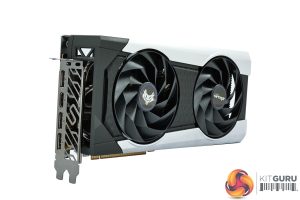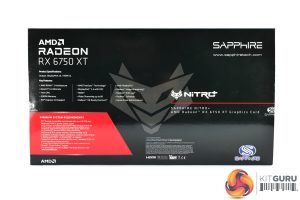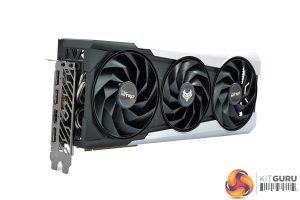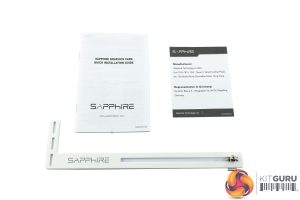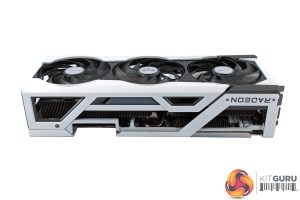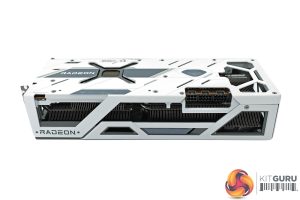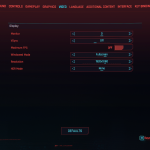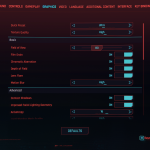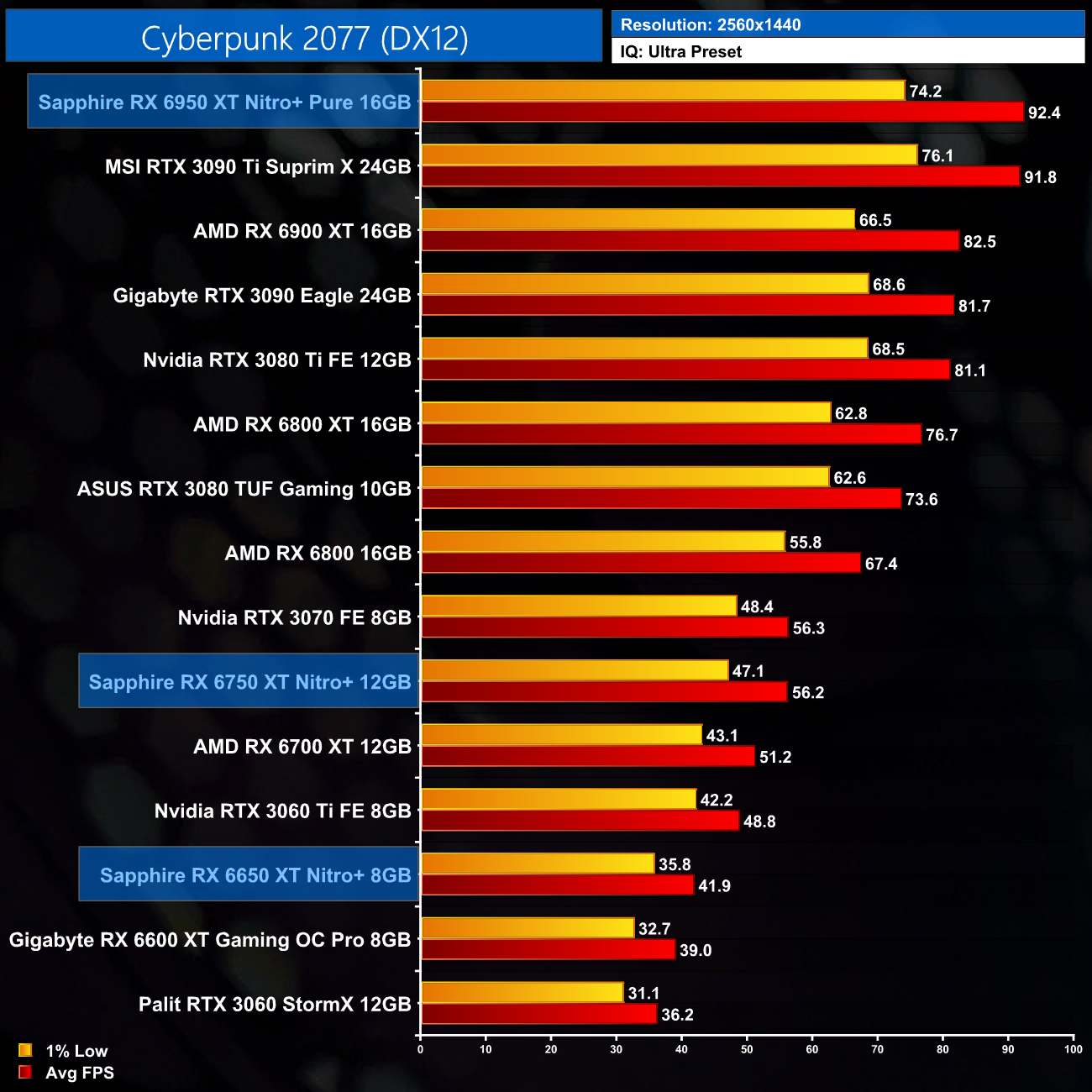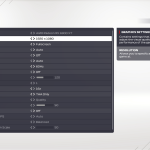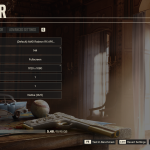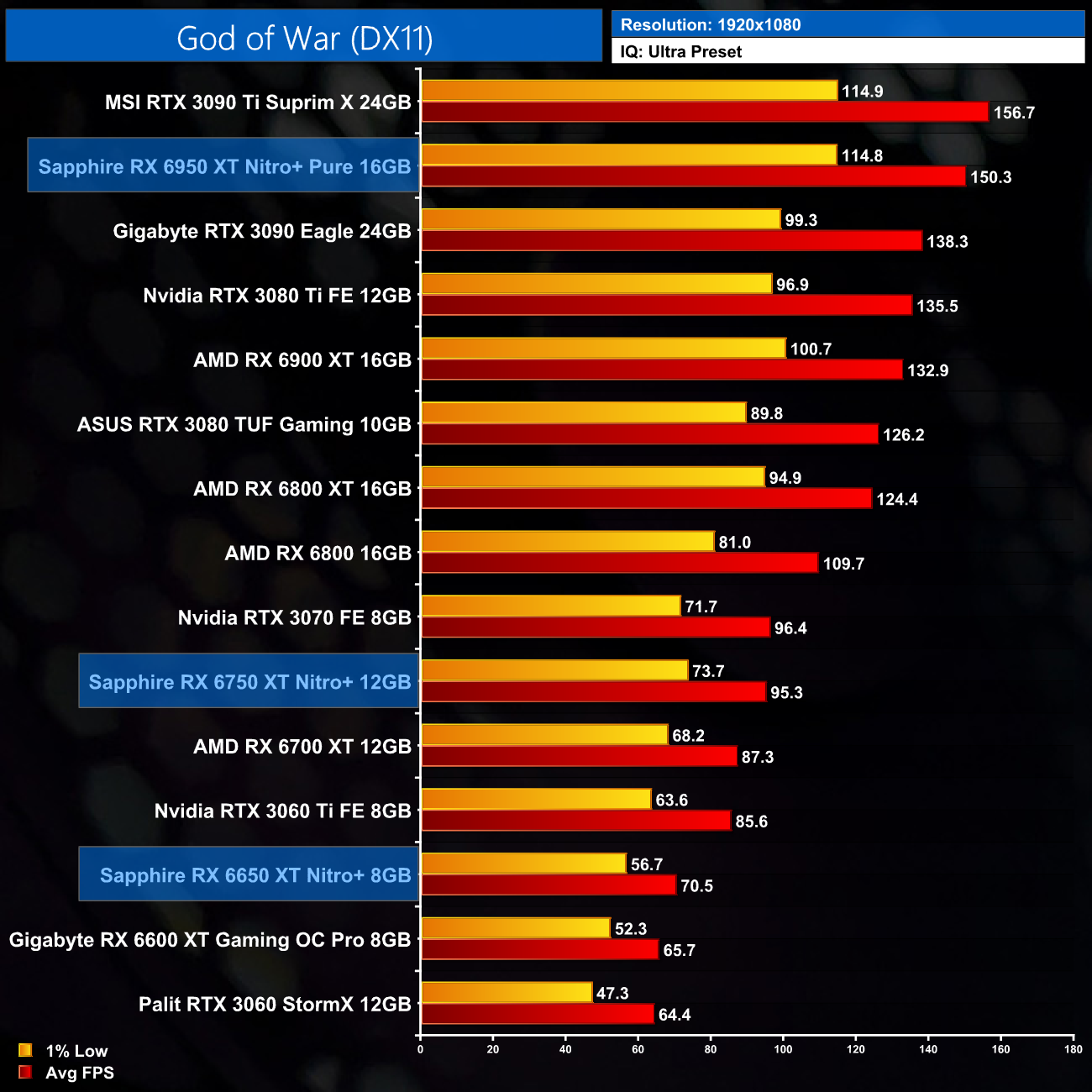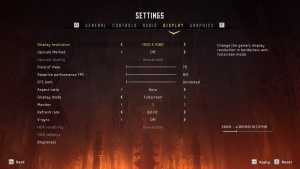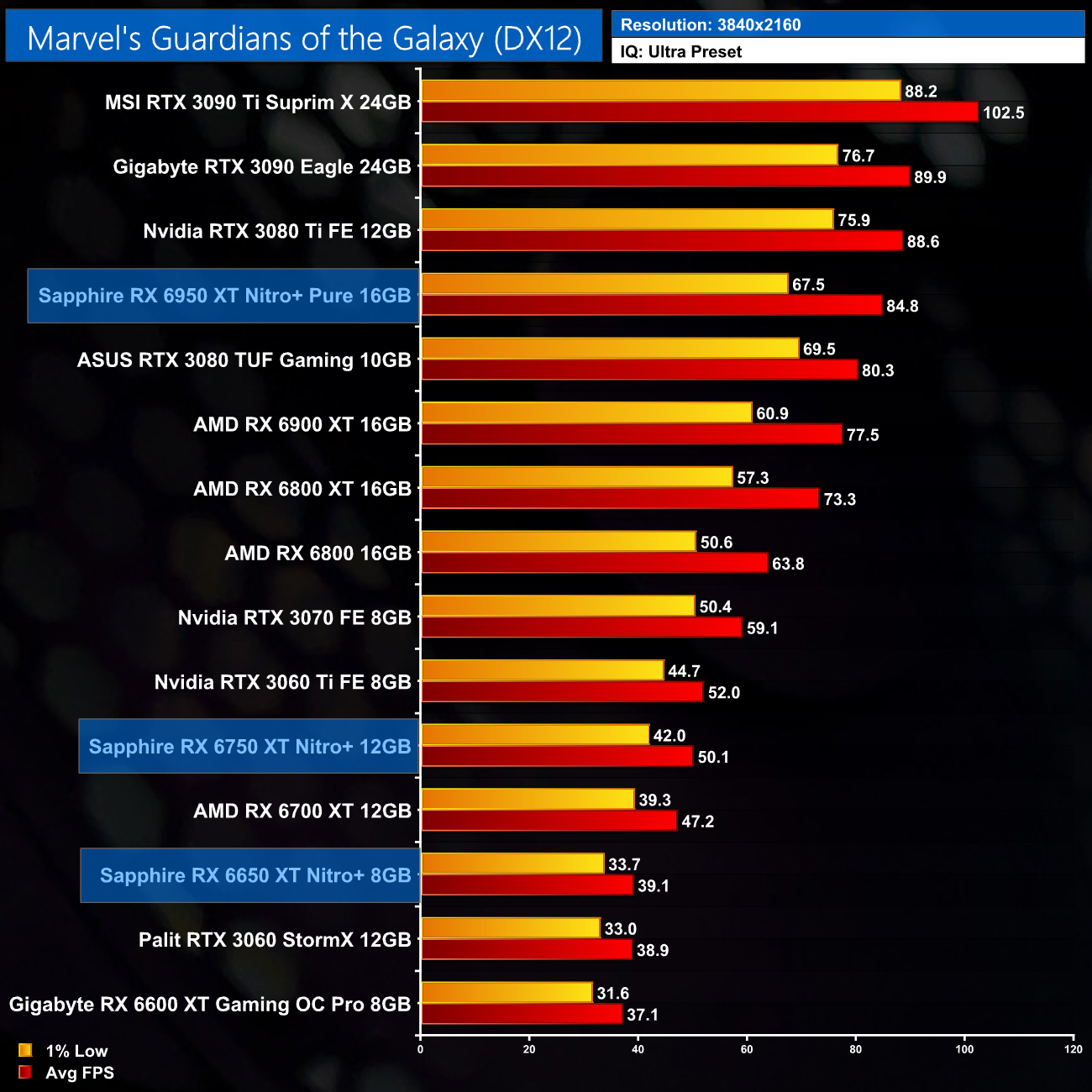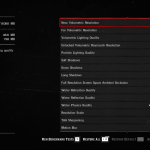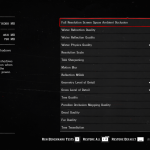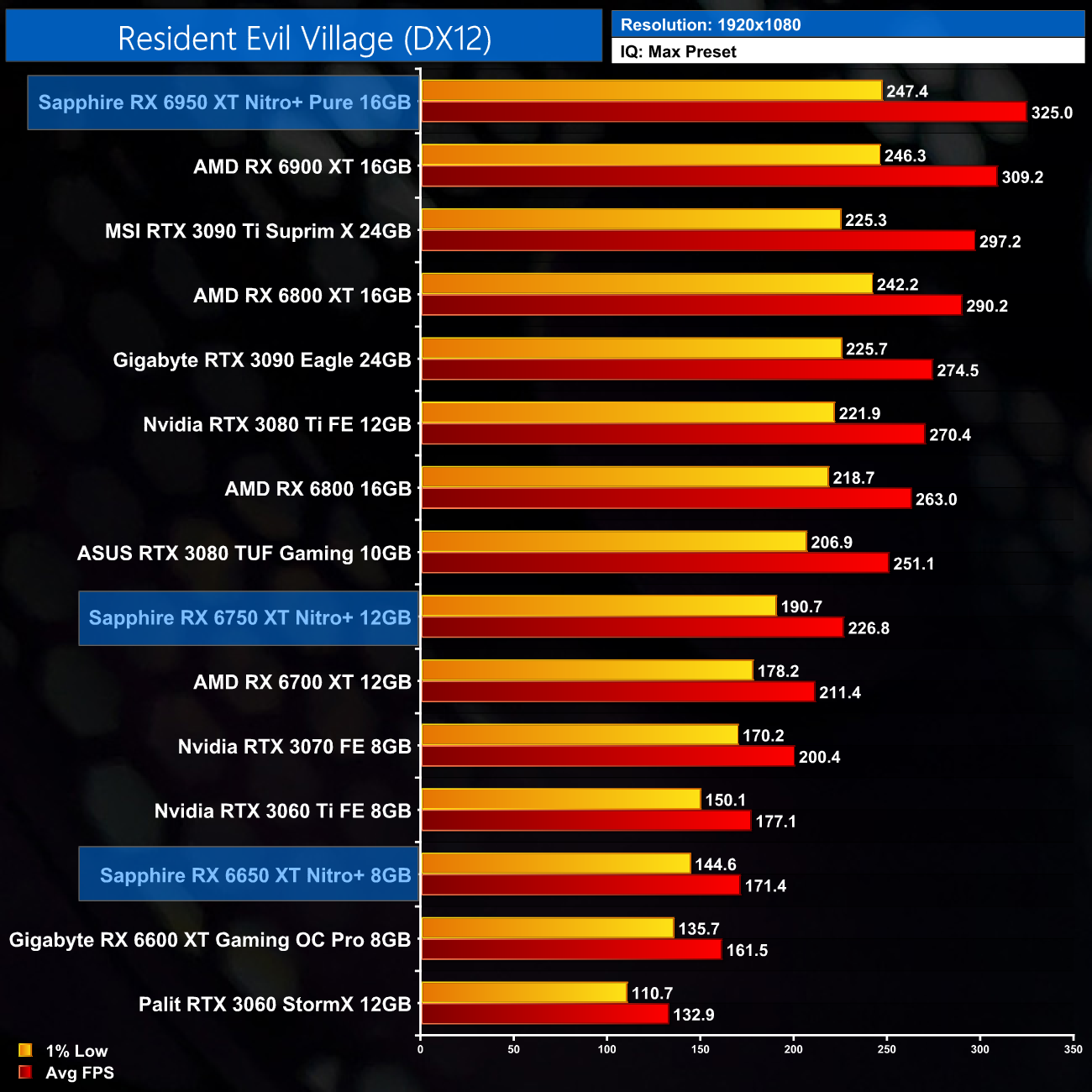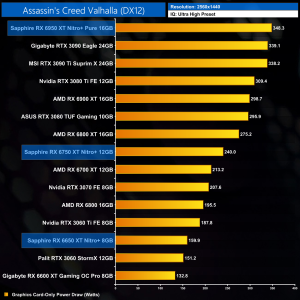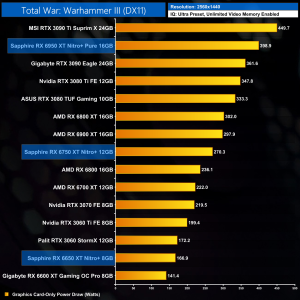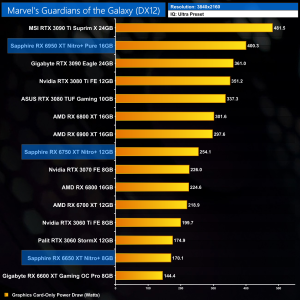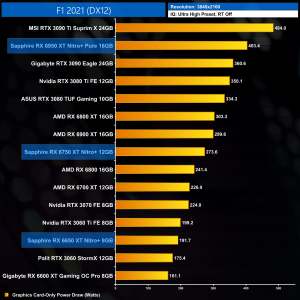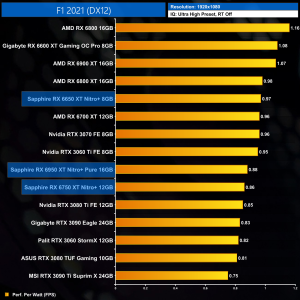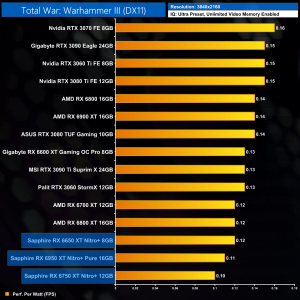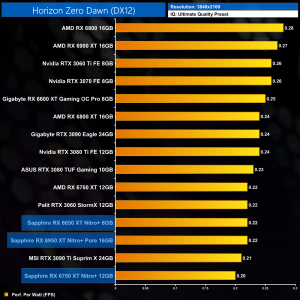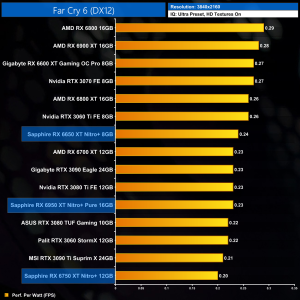Today sees the launch of AMD's latest GPUs – the RX 6950 XT, 6750 XT and 6650 XT. Based on the same RDNA 2 architecture and 7nm process as the rest of the RX 6000 series, this launch is best described as a mild refresh, with the core GPU make-up remaining unchanged. Instead, we are simply getting higher clock speeds and faster memory modules – so just how much more performance is on offer from these new models?
Unlike previous AMD launches, today we are not focusing on an ‘MBA' reference design. Instead, Sapphire sent us its Nitro+ design for the RX 6650 XT and 6750 XT, while we are looking at the brand-new Nitro+ Pure for the RX 6950 XT.
These are factory overclocked models, with increased power limits and dual-BIOS support, which are all features that enthusiasts will be interested in. Let's find out just how good these cards are.
| RX 6950 XT | RX 6900 XT | RX 6750 XT | RX 6700 XT | RX 6650 XT | RX 6600 XT | |
| Architecture | RDNA 2 | RDNA 2 | RDNA 2 | RDNA 2 | RDNA 2 | RDNA 2 |
| Manufacturing Process | 7nm | 7nm | 7nm | 7nm | 7nm | 7nm |
| Transistor Count | 26.8 billion | 26.8 billion | 17.2 billion | 17.2 billion | 11.1 billion | 11.1 billion |
| Die Size | 519 mm² | 519 mm² | 336 mm² | 336 mm² | 237 mm² | 237 mm² |
| Ray Accelerators | 80 | 80 | 40 | 40 | 32 | 32 |
| Compute Units | 80 | 80 | 40 | 40 | 32 | 32 |
| Stream Processors | 5120 | 5120 | 2560 | 2560 | 2048 | 2048 |
| Game GPU Clock | Up to 2100MHz | Up to 2015MHz | Up to 2495MHz | Up to 2424MHz | Up to 2410MHz | Up to 2359MHz |
| Boost GPU Clock | Up to 2310MHz | Up to 2250MHz | Up to 2600MHz | Up to 2581MHz | Up to 2635MHz | Up to 2589MHz |
| ROPs | 128 | 128 | 64 | 64 | 64 | 64 |
| AMD Infinity Cache | 128MB | 128MB | 96MB | 96MB | 32MB | 32MB |
| Memory | 16GB GDDR6 18Gbps | 16GB GDDR6 16Gbps | 12GB GDDR6 18Gbps | 12GB GDDR6 16Gbps | 8GB GDDR6 17.5Gbps | 8GB GDDR6 16Gbps |
| Memory Bandwidth | 576 GB/s | 512 GB/s | 432 GB/s | 384 GB/s | 280 GB/s | 256 GB/s |
| Memory Interface | 256-bit | 256-bit | 192-bit | 192-bit | 128-bit | 128-bit |
| Board Power | 335W | 300W | 250W | 230W | 180W | 160W |
Before diving into the review, it's worth quickly recapping the core spec of the new cards. In essence, AMD has simply taken the existing RX 6900 XT, 6700 XT and 6600 XT, and added a factory overclock alongside faster memory modules. As you can see, the fundamental makeup of each GPU is unchanged – core count, RT cores, ROPS and Infinity Cache is all the same. It just comes down to GPU and memory frequency.
That does also necessitate an increase to power draw, with the RX 6950 XT rated at 335W, the 6750 XT at 250W and the 6650 XT at 180W. All three Sapphire cards we are looking at today have even higher power limits though, but we are on hand to utilise our best ever GPU power testing methodology in this review, so read on for our most detailed power testing yet.

The Sapphire RX 6650 XT Nitro+ ships in a purple-coloured box, with the Nitro logo taking pride of place on the front. On the back, Sapphire highlights a few key features of the GPU itself.
Inside, accessories are sparse – we find a quick start guide and manufacturer not, but that's it.
Taking a look at the card itself, it is in keeping with the Nitro+ styling that we have become accustomed to over the last couple of years. That means we have a silver and black plastic shroud that looks clean and fairly minimalistic – it certainly doesn't scream ‘gamer' at you.
We can also note the two 100mm fans nestled in the shroud. If they look slightly different to you, that's because they are now using ‘Second Generation Angular Velocity' fan blades which Sapphire claims can offer up to 44% more air pressure, at 30dBa, when compared to the first generation design.
For a dual-slot card, it's by no means tiny – it measures in at 260 x 130 x 57.57mm. The thickness is most eye-catching, as this is approaching a triple-slot form-factor, but it should fit in most cases on the market.
We can also note a tasteful silver backplate, made from metal. This sports the Nitro+ and Radeon logos, while there's a large cut-out at the end of the backplate to allow airflow directly through the heatsink and out the back of the card.
Towards the I/O bracket, it is worth pointing out the dual-BIOS switch, allowing a choice of the Performance or Silent modes. There is even a third option to let users toggle between these BIOS modes using Sapphire's Trixx software, which is a nice touch.
Power requirements consist of 1x 8-pin PCIe connector, and we can note 3x DisplayPort and 1x HDMI 2.1 video outputs.
As for the Sapphire RX 6750 XT Nitro+, this ships in an eye-catching blue, black and yellow box, with the Nitro+ logo placed centrally. On the back, more key features of the GPU are highlighted.
Inside, we get the same documentation, but more interesting is the included GPU support bracket which will just help prevent any of the dreaded ‘GPU sag'.
Looking at the design of the card itself, it looks almost identical to the RX 6700 XT Nitro+ I reviewed last year. The silver and black shroud design appears unchanged, with the main visual difference coming due to the use of the ‘Second Generation Angular Velocity' fan blades, which are more angular, and less curved, than the previous design.
In terms of size, the 6750 XT Nitro+ is not playing around – we can see why Sapphire decided to include a bracket, as it measures 310 x 130 x 62.19mm, making it a proper triple-slot card. It also weighs in at 1.16kg on my scales.
Once more we get a full-length metal backplate, with another large cut-out in the metal towards the end of the card. We can also note the dual-BIOS switch, allowing a choice of the Performance or Silent modes, and the third option to toggle between the two using Trixx.
Power inputs are now 2x 8-pin connectors, up from 1x 8-pin and 1x 6-pin, but we have the same 3x DisplayPort and 1x HDMI 2.1 video outputs.
Brand new for the RX 6X50 series is Sapphire's Nitro+ Pure line, and we have this in the form of the RX 6950 XT. It ships in a light grey and yellow box, while the back is white and highlights key features of the GPU.
Inside, we find more of the same documentation, but there is a white GPU support bracket included as well.
Clearly, the ‘Pure' moniker describes the fact this new graphics card is mostly white, with white metal sections sitting alongside the three black fans. It's a lovely-looking graphics card and the photos don't quite do it justice, but it's good to see Sapphire trying something new as well.
Those three fans each measure 100mm, and once more they are using the new ‘Second Generation Angular Velocity' fan blades for increased air pressure.
This is a very large graphics card however, measuring 320 x 134.75 x 71.57mm – making it a 3.5 slot design. It also weighs over 1.5kg on my scales, so you will definitely want to use the included support bracket.
Thankfully, the white theme continues over to the metal backplate, with just a few grey elements to keep things interesting – it really is a beautiful graphics card.
As expected, we can also note the dual-BIOS switch, allowing a choice of the Performance or Silent modes, and the third option to toggle between the two using Trixx.
Power requirements are increased for the RX 6950 XT – it needs 2x 8-pin and 1x 6-pin connectors. We can also note 3x DisplayPort and 1x HDMI 2.1 video outputs.
Driver Notes
- All AMD GPUs (except RX 6X50 series) were benchmarked with the public Adrenalin 22.3.1 driver.
- RX 6X50 series GPUs were benchmarked with the Adrenalin 22.10 driver supplies to press.
- All Nvidia GPUs (except RTX 3090 Ti) were benchmarked with the 511.79 driver.
- RTX 3090 Ti was benchmarked with the 512.16 driver supplied to press.
Test System:
We test using the a custom built system powered by MSI, based on Intel’s Alder Lake platform. You can read more about this system HERE and check out MSI on the CCL webstore HERE.
| CPU |
Intel Core i9-12900K
|
| Motherboard |
MSI MEG Z690 Unify
|
| Memory |
32GB (2x16GB) ADATA XPG Lancer DDR5 6000MHz
CL 40-40-40
|
| Graphics Card |
Varies
|
| SSD |
2TB MSI Spatium M480
|
| Chassis | MSI MPG Velox 100P Airflow |
| CPU Cooler |
MSI MEG CoreLiquid S360
|
| Power Supply |
Corsair 1200W HX Series Modular 80 Plus Platinum
|
| Operating System |
Windows 11 Pro 21H2
|
| Monitor |
MSI Optix MPG321UR-QD
|
| Resizable BAR |
Enabled for all supported GPUs
|
Comparison Graphics Cards List
- Gigabyte RX 6600 XT Gaming OC Pro
- AMD RX 6700 XT 12GB
- AMD RX 6800 16GB
- AMD RX 6800 XT 16GB
- AMD RX 6900 XT 16GB
- Palit RTX 3060 StormX 12GB
- Nvidia RTX 3060 Ti FE 8GB
- Nvidia RTX 3070 FE 8GB
- ASUS RTX 3080 TUF Gaming 10GB
- Nvidia RTX 3080 Ti FE 12GB
- Gigabyte RTX 3090 Eagle 24GB
- MSI RTX 3090 Ti Suprim X 24GB
All cards, except the MSI RTX 3090 Ti Suprim X, were tested at reference specifications.
Software and Games List
- 3DMark Fire Strike & Fire Strike Ultra (DX11 Synthetic)
- 3DMark Time Spy (DX12 Synthetic)
- Assassin's Creed Valhalla (DX12)
- Cyberpunk 2077 (DX12)
- Dying Light 2 (DX12)
- F1 2021 (DX12)
- Far Cry 6 (DX12)
- Forza Horizon 5 (DX12)
- God of War (DX11)
- Horizon Zero Dawn (DX12)
- Marvel's Guardians of the Galaxy (DX12)
- Metro Exodus Enhanced Edition (DXR)
- Red Dead Redemption 2 (DX12)
- Resident Evil Village (DX12)
- Total War: Warhammer III (DX11)
We run each benchmark/game three times, and present mean averages in our graphs. We use FrameView to measure average frame rates as well as 1% low values across our three runs.
Fire Strike is a showcase DirectX 11 benchmark for modern gaming PCs. Its ambitious real-time graphics are rendered with detail and complexity far beyond other DirectX 11 benchmarks and games. Fire Strike includes two graphics tests, a physics test and a combined test that stresses the CPU and GPU. (UL).
3DMark Time Spy is a DirectX 12 benchmark test for Windows 10 gaming PCs. Time Spy is one of the first DirectX 12 apps to be built the right way from the ground up to fully realize the performance gains that the new API offers. With its pure DirectX 12 engine, which supports new API features like asynchronous compute, explicit multi-adapter, and multi-threading, Time Spy is the ideal test for benchmarking the latest graphics cards. (UL).
Kicking off the benchmarks with a look at 3DMark, we don't see massive performance increases here for the new RX 6X50 series of cards. Fire Strike is particularly meagre, with the 6750 XT only outperforming the RX 6700 XT by 5%, though thankfully the 6950 XT does better, managing a 10% lead over the RX 6900 XT in Fire Strike and Time Spy.
Real-time ray tracing is incredibly demanding. The latest graphics cards have dedicated hardware that’s optimized for ray-tracing. The 3DMark DirectX Raytracing feature test measures the performance of this dedicated hardware. Instead of using traditional rendering techniques, the whole scene is ray-traced and drawn in one pass. The result of the test depends entirely on ray-tracing performance. (UL).
Ray tracing isn't a huge boost for the RX 6X50 series either, as it doesn't have any extra RT cores or streaming processors to aid with BVH traversal. Instead, the only increase in ray tracing performance comes due to the increased clock speed, and performance scales similarly to 3DMark Time Spy.
Assassin's Creed Valhalla is an action role-playing video game developed by Ubisoft Montreal and published by Ubisoft. It is the twelfth major installment and the twenty-second release in the Assassin's Creed series, and a successor to the 2018's Assassin's Creed Odyssey. The game was released on November 10, 2020, for Microsoft Windows, PlayStation 4, Xbox One, Xbox Series X and Series S, and Stadia, while the PlayStation 5 version was released on November 12. (Wikipedia).
Engine: AnvilNext 2.0. We test using the Ultra High preset, DX12 API.
Assassin's Creed Valhalla is our first game to look at, starting at 1080p. Here we can see the RX 6650 XT averaging 93FPS, making it 5% faster than the original RX 6600 XT. The RX 6750 XT is 7% faster than the vanilla 6700 XT this time averaging just under 118FPS which is not at all far from the RX 6800. The RX 6950 XT meanwhile breaks past 150FPS, delivering 7% more performance than the RX 6900 XT.
Up at 1440p, the margins haven't changed for either the RX 6650 XT or the 6750 XT – both models are still 5 and 7% faster, respectively, than the original versions, which is fine but no great shakes. The RX 6950 XT however now sees a 10% boost over the 6900 XT, but do remember this is the factory overclocked Nitro+ model, whereas we tested the reference 6900 XT card.
As for 4K, the 6950 XT is now 12% faster than the RX 6900 XT, so it beats out even the RTX 3090 Ti Suprim X. The RX 6650 and 6750 XT are more muted with their performance gains however, with both cards just a couple of FPS ahead of their original versions.
Cyberpunk 2077 is a 2020 action role-playing video game developed and published by CD Projekt. The story takes place in Night City, an open world set in the Cyberpunk universe. Players assume the first-person perspective of a customisable mercenary known as V, who can acquire skills in hacking and machinery with options for melee and ranged combat. Cyberpunk 2077 was released for Microsoft Windows, PlayStation 4, Stadia, and Xbox One on 10 December 2020. (Wikipedia).
Engine: REDengine 4. We test using the Ultra preset, DX12 API.
As for Cyberpunk 2077, here we see some bigger performance improvements from the new AMD GPUs. At 1080p, the RX 6650 XT delivers an 8% uplift in performance when compared to the RX 6600 XT, while the RX 6750 XT is actually 10% faster than the reference 6700 XT. The 6950 XT does see the biggest relative improvements however, with a 12% boost over the RX 6900 XT.
Those trends stay very consistent as we step up to 1440p. The 6650 XT starts to struggle a bit more at this resolution, but it's still 7% ahead of the 6600 XT. Meanwhile, the 6750 XT delivers a solid 56FPS on average, while the 6950 XT is neck and neck with the RTX 3090 Ti at the top of the chart.
Up at 4K, we can see similar improvements from the 6650 and 6750 XT, however both are still well below 30FPS and are definitely not suited to this resolution. The RX 6950 XT is once more 12% faster than the RX 6900 XT, but it falls short of the RTX 3090 Ti, just squeaking ahead of the RTX 3090.
Dying Light 2: Stay Human is a 2022 action role-playing game developed and published by Techland. The sequel to Dying Light (2015), the game was released on February 4, 2022 for Microsoft Windows, PlayStation 4, PlayStation 5, Xbox One, and Xbox Series X/S. (Wikipedia).
Engine: C-Engine. We test using the High preset, DX12 API.
Interestingly, Dying Light 2 delivered the biggest relative gains for each GPU tested – and anomalously so, with the performance gains shown by the 6X50 cards much larger in this title than any other game I tested. My working theory is that AMD has made some driver optimisations for Dying Light 2 that weren't present when I tested the original 6600/6700/6900 XT, but I have not yet had time to test that – I will be sure to report back if I do find other performance increases for AMD GPUs.
F1 2021 is the official video game of the 2021 Formula One and Formula 2 Championships developed by Codemasters and published by EA Sports. The game was released for Microsoft Windows, PlayStation 4, PlayStation 5, Xbox One and Xbox Series X/S on 16 July 2021. The deluxe edition was launched three days earlier on 13 July 2021. (Wikipedia).
Engine: EGO. We test using the Ultra High preset, ray tracing disabled, DX12 API.
F1 2021 is pretty representative of overall performance from these new cards. The RX 6650 XT delivers an extra 6-7% performance over the RX 6600 XT, whereas the 6750 XT is a decent 9-11% faster than the vanilla model. The Nitro+ RX 6950 XT continues to impress, with 12-14% gains over the RX 6900 XT shown here.
Far Cry 6 is a 2021 action-adventure first-person shooter game developed by Ubisoft Toronto and published by Ubisoft. It is the sixth main installment in the Far Cry series and the successor to 2018's Far Cry 5. The game was released on October 7, 2021, for Microsoft Windows, PlayStation 4, PlayStation 5, Xbox One, Xbox Series X/S, Stadia, and Amazon Luna. (Wikipedia).
Engine: Dunia Engine. We test using the Ultra preset, HD Textures enabled, DX12 API.
Far Cry 6 is slightly less impressive for the new GPUs. At 1080p we can definitely see CPU bottlenecking, as the top three GPUs on the chart are all clustered very close together. The RX 6650 XT is just 5% faster than the 6600 XT, while we see a 7% boost from the 6750 XT when compared to the vanilla 6700 XT.
As for 1440p, we are much more GPU-limited at this resolution, and the RX 6950 XT is now 11% faster than the 6900 XT, which is much more like it. Both the RX 6650 XT and 6750 XT see similar performance uplifts to what we see at 1080p, with each gaining a handful of frames compared to the original models.
Although not designed for 4K gaming, the 6750 XT can do a job here in Far Cry 6, though it is pipped to the post by the RTX 3070. The RX 6950 XT remains at the top of the chart though, but do remember this is an AMD sponsored title and performance definitely favours Team Red.
Forza Horizon 5 is a 2021 racing video game developed by Playground Games and published by Xbox Game Studios. The twelfth main instalment of the Forza series, the game is set in a fictionalised representation of Mexico. It was released on 9 November 2021 for Microsoft Windows, Xbox One, and Xbox Series X/S. (Wikipedia).
Engine: ForzaTech. We test using the Extreme preset, DX12 API.
Despite not being sponsored by AMD, Forza Horizon 5 sees a massive performance swing in favour of the Radeon GPUs. Even the RX 6800 is faster than the RTX 3090 Ti at 1080p, so it's no surprise to see the RX 6950 XT dominating at every resolution tested. The RX 6750 XT is also fiercely competitive, out-doing the RTX 3070 at every resolution, too.
God of War is an action-adventure game developed by Santa Monica Studio and published by Sony Interactive Entertainment (SIE). It was released worldwide on April 20, 2018, for the PlayStation 4 with a Microsoft Windows version released on January 14, 2022. (Wikipedia).
Engine: Sony Santa Monica Proprietary. We test using the Ultra preset, DX11 API.
God of War is more favourable to Nvidia graphics cards, but we can still see the kind of performance improvements we have come to expect from the RX650 series – the RX 6650 XT is 7% faster than its predecessor, while the 6750 XT adds 8-9% performance over the RX 6700 XT. Compared to its Nvidia rivals however, the RX 6950 XT is underperforming, falling just short of the RTX 3080 Ti at 4K.
Horizon Zero Dawn is an action role-playing game developed by Guerrilla Games and published by Sony Interactive Entertainment. The plot follows Aloy, a hunter in a world overrun by machines, who sets out to uncover her past. It was released for the PlayStation 4 in 2017 and Microsoft Windows in 2020. (Wikipedia).
Engine: Decima. We test using the Ultimate Quality preset, DX12 API.
Horizon Zero Dawn is very consistent with its results. We can see 5-6% gains for the RX 6650 XT at every resolution, while the RX 6750 XT is 8-9% faster than the RX 6700 XT. The RX 6950 XT also does well, outperforming the RTX 3090 Ti at 1080p and 1440p, though it falls back at 4K.
Marvel's Guardians of the Galaxy is a 2021 action-adventure game developed by Eidos-Montréal and published by Square Enix. Based on the Marvel Comics superhero team Guardians of the Galaxy, the game was released for Microsoft Windows, Nintendo Switch, PlayStation 4, PlayStation 5, Xbox One, and Xbox Series X/S on October 26, 2021. (Wikipedia).
Engine: Dawn Engine. We test using the Ultra preset, DX12 API.
Marvel's Guardians of the Galaxy is an Nvidia sponsored title and AMD GPUs do suffer somewhat here, particularly with the 1% lows. At 1440p the RX 6750 XT is only a touch faster than the RTX 3060 Ti, while even at 4K the RX 6950 XT delivers just 9% more performance than the RX 6900 XT.
Red Dead Redemption 2 is a 2018 action-adventure game developed and published by Rockstar Games. The game is the third entry in the Red Dead series and is a prequel to the 2010 game Red Dead Redemption. Red Dead Redemption 2 was released for the PlayStation 4 and Xbox One in October 2018, and for Microsoft Windows and Stadia in November 2019. (Wikipedia).
Engine: Rockstar Advance Game Engine (RAGE). We test by manually selecting Ultra settings (or High where Ultra is not available), TAA, DX12 API.
Moving onto Red Dead Redemption 2, this is one of the better games for the RX650 series of cards. At 1080p, we are looking at an 8% performance improvement for the RX 6650 XT, when compared against the 6600 XT, while the 6750 XT is 7% ahead of the RX 6700 XT. The Nitro+ 6950 XT is once more top of the chart however, just edging ahead of the RTX 3090 Ti.
Up at 1440p, the performance trends are very similar, as we can see small but not insignificant gains from all three of the new GPUs, when comparing them to their predecessors. The 6950 XT is still just about faster than the RTX 3090 Ti, too, but only by a couple of frames.
As for 4K, this is too much for the 6650 XT to handle, but the 6750 XT still puts in a good shift and is only just slower than the RTX 3070. Sapphire's RX 6950 XT does fall behind the RTX 3090 Ti however, but that is to be expected at this resolution.
Resident Evil Village is a survival horror game developed and published by Capcom. The sequel to Resident Evil 7: Biohazard (2017), players control Ethan Winters, who is searching for his kidnapped daughter; after a fateful encounter with Chris Redfield, he finds himself in a village filled with mutant creatures. The game was announced at the PlayStation 5 reveal event in June 2020 and was released on May 7, 2021, for Windows, PlayStation 4, PlayStation 5, Xbox One, Xbox Series X/S and Stadia. (Wikipedia).
Engine: RE Engine. We test using the Max preset, with V-Sync disabled, DX12 API.
As for Resident Evil Village, this AMD-sponsored title has a heavy bias towards Team Red, and we can see the RX 6X50 cards performing strongly at every resolution. Even at 4K, the 6950 XT proves faster than the RTX 3090 Ti, and the 6750 XT is comfortably faster than the RTX 3070 at 1440p.
Total War: Warhammer III is a turn-based strategy and real-time tactics video game developed by Creative Assembly and published by Sega. It is part of the Total War series, and the third to be set in Games Workshop's Warhammer Fantasy fictional universe (following 2016's Total War: Warhammer and 2017's Total War: Warhammer II). The game was announced on February 3, 2021 and was released on February 17, 2022.(Wikipedia).
Engine: TW Engine 3 (Warscape). We test using the Ultra preset, with unlimited video memory enabled, DX11 API.
Closing out with Total War: Warhammer III, by now you have got the picture – the RX 6650 XT sees a 7% performance lead over the RX 6600 XT at 1080p, while the 6750 XT is 9% faster than the 6700 XT. The RX 6950 XT sees almost a 15% performance bump over the 6900 XT, but it is still short of the RTX 3090 Ti.
Meanwhile, at 1440p, those performance differentials are almost exactly the same. The RX 6950 XT does drop off a bit more however, coming in short of the RTX 3080 Ti, and the 6750 XT is beaten by the RTX 3060 Ti, though do remember this game does prefer Nvidia GPUs.
Lastly, at 4K, only the RX 6950 XT manages playable frame rates, but still can't match even the RTX 3080 10GB, coming in 13% faster than the RX 6900 XT.
Here we present frame rate figures for each graphics card, averaged across all 12 games on test today. These figures can disguise significant variations in performance from game to game, but provide a useful overview of the sort of performance you can expect at each resolution tested.
Averaged across our 12 games, at 1080p the Sapphire RX 6650 XT Nitro+ ran 6% faster than the RX 6600 XT, while the 6750 XT proved 8% faster than the RX 6700 XT. The big dog, the RX 6950 XT, ran 9% faster than the vanilla RX 6900 XT, which isn't too shabby.
Up at 1440p, both the RX 6650 XT and RX 6750 XT scale exactly the same as they do at 1080p, so we're talking gains of 6% and 8%, respectively. The RX 6950 XT is more impressive, delivering an extra 11% when compared to the RX 6900 XT.
Then at 4K, once more the RX 6650 XT is 6% faster than the RX 6600 XT, while the RX 6750 XT is still 8% faster than the vanilla 6700 XT. At its very best, the RX 6950 XT delivers 12% more performance than AMD's previous flagship, the RX 6900 XT.
I have already mentioned this, but I do just want to stress that these results are very much a best case scenario for the RX 6X50 series, as we are testing Sapphire's heavily overclocked Nitro+ cards. The RX 6950 XT Nitro+ Pure, for instance, ships with an 11% factory overclock compared to the reference RX 6950 XT. As ever other card we have tested, bar the MSI RTX 3090 Ti, has been benchmarked at reference clock speed, this will slightly skew the data. If we were comparing reference models against reference models, I would expect smaller margins than what is shown here.
Here we test Cyberpunk 2077, with RT Lighting set to Ultra.
Ray tracing performance has not changed much compared to the rasterised performance in Cyberpunk, shown earlier in the review. The only reason the RX 6X50 cards are performing better here is due to their clock speed, but that still can't come close to making up the performance advantage currently held by Nvidia GPUs in this game.
Here we test Metro Exodus Enhanced Edition, with the in-game ray tracing effects set to Ultra.
The RX 6X50 cards manage much more playable frame rates in Metro Exodus Enhanced Edition, with the 6950 XT averaging over 100FPS at 1080p, but Nvidia still has the upper hand here. At 1440p, the 6950 XT is neck and neck with the RTX 3070.
Here we test Resident Evil Village, this time testing with the in-game ray tracing effects set to High.
Lastly, Resident Evil Village is much lighter in terms of the ray tracing workload, so AMD GPUs aren't as negatively impacted as in Cyberpunk or Metro Exodus. The RX 6750 XT is almost managing 60FPS at 4K, for example, and isn't too far off the performance of the RTX 3070.
Here we present the average clock speed for each graphics card while running Cyberpunk 2077 for 30 minutes. We use GPU-Z to record the GPU core frequency during gameplay. We calculate the average core frequency during the 30 minute run to present here.
For our clock speed testing, we put both BIOS modes for each of the cards to the test. We can clearly see some big increases in clock speed compared to the original RX 6000-series cards – the Nitro+ RX 6650 XT is over 200MHz faster than its predecessor, for instance, while the RX 6750 XT is about 180MHz faster. Even the RX 6950 XT comes in over 230MHz faster than the RX 6900 XT, which is quite impressive considering it has the largest core-count of any RDNA2 GPU.
For our temperature testing, we measure the peak GPU core temperature under load. A reading under load comes from running Cyberpunk 2077 for 30 minutes.
Thermally, these Sapphire Nitro+ models perform very well. As we'd expect, the 6950 XT runs the hottest as it has the highest power rating, but the GPU edge temperature remains below 80C. The RX 6650 XT and RX 6750 XT are even more impressive, keeping the edge temperature below 70C in the case of the RX 6650 XT, while even the Silent BIOS on the RX 6750 XT just reaches over 70 degrees.
We take our noise measurements with the sound meter positioned 1 foot from the graphics card. I measured the noise floor to be 32 dBA, thus anything above this level can be attributed to the graphics cards. The power supply is passive for the entire power output range we tested all graphics cards in, while all CPU and system fans were disabled. A reading under load comes from running Cyberpunk 2077 for 30 minutes.
The sheer lack of noise is easily the most impressive thing about these Sapphire cards however. Regardless of which card or BIOS mode was used, the fans were barely audible, and I had to press my ear right up against the cards to double check the fans were even spinning. 32dBa is actually the noise floor in my testing environment too, which goes to show how little noise these cards make, that my sound meter could not distinguish a difference between the fans spinning or sitting idle. It is mightily impressive stuff, especially considering the fact that the temperatures are still very good.
Here we present power draw figures for the graphics card-only, on a per-game basis for all twelve games we tested at 1080p. This is measured using Nvidia's Power Capture Analysis Tool, also known as PCAT. You can read more about our updated power draw testing methodology HERE.
Per-Game Results at 1080p:
Click to enlarge.
12-Game Average at 1080p:
The increase in clock and memory speed necessitates an increase to power draw. Sapphire raised power targets even further than the reference figures however, but we can still see some significant jumps at 1080p – the 6950 XT draws over 70W more than the 6900 XT, while the 6750 XT is pulling another 40W over the RX 6700 XT.
Here we present power draw figures for the graphics card-only, on a per-game basis for all twelve games we tested at 1440p. This is measured using Nvidia's Power Capture Analysis Tool, also known as PCAT. You can read more about our updated power draw testing methodology HERE.
Per-Game Results at 1440p:
Click to enlarge.
12-Game Average at 1440p:
Power figures get even higher at 1440p, with the RX 6950 XT now approaching 400W, not at all far off a 100W increase compared to the 6900 XT. The RX 6750 XT is pulling 266W, and that's still over 40W more than the RX 6700 XT, while the 6650 XT draws just over 170W.
Here we present power draw figures for the graphics card-only, on a per-game basis for all twelve games we tested at 2160p (4K). This is measured using Nvidia's Power Capture Analysis Tool, also known as PCAT. You can read more about our updated power draw testing methodology HERE.
Per-Game Results at 2160p:
Click to enlarge.
12-Game Average at 2160p:
As for 4K, power draw does hit over 400W for the RX 6950 XT, though the other two cards are not drawing much more power than they did at 1440p. Still, we are looking at some very sizeable power draw increases for the 6X50 series compared to the original models.
Using the graphics card-only power draw figures presented earlier in the review, here we present performance per Watt on a per-game basis for all twelve games we tested at 1080p.
Per-Game Results at 1080p:
Click to enlarge.
12-Game Average at 1080p:
Such large increases in power draw, despite fairly insignificant performance improvements, means that performance per Watt efficiency of all three models is well below that of the original RX 6000 series cards. The RX 6650 XT, for instance, is about 10% less efficient than the vanilla RX 6600 XT.
Using the graphics card-only power draw figures presented earlier in the review, here we present performance per Watt on a per-game basis for all twelve games we tested at 1440p.
Per-Game Results at 1440p:
Click to enlarge.
12-Game Average at 1440p:
The same goes at 1440p. The original RX 6900 XT is one of the most efficient GPUs on the market – Sapphire's RX 6950 XT Nitro+ is about 17% less efficient in terms of performance per Watt.
Using the graphics card-only power draw figures presented earlier in the review, here we present performance per Watt on a per-game basis for all twelve games we tested at 2160p.
Per-Game Results at 2160p:
Click to enlarge.
12-Game Average at 2160p:
And then at 4K, we can see the RX 6950 XT Nitro+ is now 19% less efficient than the original RX 6900 XT. That's the price you pay to push clock speeds that bit higher, as we quickly run into diminishing returns.
We measure system-wide power draw from the wall while running Cyberpunk 2077 for 30 minutes.
For those interested in our total system power draw figures, they mirror the results shown earlier – power draw is up significantly, with the RX 6750 XT drawing more than the reference RX 6800. The RX 6950 XT hits over 600W, too – not as much as the RTX 3090 Ti, but you'll still want a very solid PSU.
For our manual overclocking tests, we used AMD's built-in performance tuning tools. Our best results are as below.
RX 6650 XT
RX 6750 XT
RX 6950 XT
All three overclocks resulted in pretty sizeable increases to the average clock speed of the cards in question, though most impressive is the RX 6950 XT, which ran almost 300MHz faster than it did out of the box.
These overclocks resulted in pretty similar-sized performance gains, where we saw typically an extra 5-8% depending on the title. Again, it's not nothing, and to be honest I was slightly surprised there was even this much headroom left, though of course this will vary from card to card.
With more and more rumours pointing to AMD's next-gen GPU architecture, one might consider today's launch the last stand for RDNA 2. AMD has released the RX 6950 XT, 6750 XT and 6650 XT, using the same Navi 21, Navi 22 and Navi 23 GPUs that we are accustomed to, but bumping the frequencies and memory speeds to net extra performance. It's very much a refresh, but just how much difference has it made?
Well, to get right into the performance summary, over our 12 games we found the RX 6650 XT to run 6% faster than the RX 6600 XT, the RX 6750 XT is 8% faster than the RX 6700 XT, while the RX 6950 XT proved 10-12% faster than the RX 6900 XT depending on the resolution tested.
Just to re-iterate as well, these numbers don't take into account the fact that we tested three heavily factory overclocked models from the the Sapphire Nitro+ series, while our comparison cards were all tested at reference clocks. That means, if we were testing reference models against reference models, I would expect smaller margins than what is shown here – the Nitro+ Pure RX 6950 XT has an 11% factory overclock for instance, which would definitely boost performance by a decent chunk compared to a reference card.
Additionally, the fact that the makeup of each GPU has not changed, and there's no extra RT cores, means that ray tracing performance is also just a small improvement over the original models thanks to that extra clock speed. Nvidia still has the edge in terms of its ray tracing, but AMD has now closed the gap ever so slightly due to the extra clock speed on offer.
One clear downside to the decision to increase GPU and memory frequency is the corresponding increase in power draw. This has also been exacerbated by the fact that our factory overclocked models have higher still power targets compared to AMD's reference 6X50 cards, but there's no getting around the fact that overall efficiency is worse with these new cards. The RX 6650 XT is about 10% less efficient than the RX 6600 XT for instance, while at 4K, the RX 6950 XT's performance per Watt is 19% lower than that of the vanilla RX 6900 XT.
With that in mind, it is actually a credit to Sapphire that the three cards we tested today all proved to run cool and quiet, despite the increased power limits. Noise levels are a particular highlight, and I would say these are some of the quietest graphics card I have ever reviewed, with noise levels hovering around the 32dBa mark. If you do end up picking up one of these Nitro+ models, I'd say they are among the best AMD-based AIB cards I have ever tested.
Still, whether or not you should actually buy a 6X50 series graphics card all depends on one thing – pricing. While AMD told us that the RX 6650 XT is going to be a direct replacement for the RX 6600 XT, the RX 6950 XT and RX 6750 XT will co-exist with the RX 6700 XT and RX 6900 XT, just at slightly higher prices. Because the only real difference between these new cards and the original GPUs is clock speed and memory frequency, it becomes pretty easy to judge whether or not it is worth paying a premium for the refreshed series.
That could be the main sticking point for this series of cards. The RX 6700 XT for instance, can be found, right now, starting at £499.99 on Overclockers UK. Sapphire also told us that the MSRP for the RX 6750 XT Nitro+ model is looking like it will hit £599.99. So that's a 20% price increase, despite just an 8% performance boost.
Plain and simply then, if you are in the market for a new GPU right now, it is definitely worth considering the RX 6X50 series… provided pricing is sensible, ideally within 5-or-so percent of the original models. But if the price is 10, 15, even 20% higher than the originals, it really is not worth splashing out on.
You will be able to see the range of AMD RX 6X50 series GPUs, including these Sapphire models, from Overclockers UK. Sapphire communicated the following MSRPs to us: NITRO+ 6950XT PURE – £1169.99, NITRO+ 6750XT – £599.99, NITRO+ 6650 – £429.99.
Discuss on our Facebook page HERE.
AMD RX 6650 XT:
Pros
- Direct replacement for RX 6600 XT.
- Faster than RTX 3060.
- Most efficient of the RX 6X50 series cards.
Cons
- Not much faster than the RX 6600 XT.
- Not worth paying a premium for over the 6600 XT if they are both available.
AMD RX 6750 XT:
Pros
- Faster than the RX 6700 XT.
- Competitive with the RTX 3070.
Cons
- Can't justify a 20% price premium over the RX 6700 XT.
- Least efficient of all RX 6X50 series.
AMD RX 6950 XT:
Pros
- Decent uplift over the 6900 XT, at least in the case of the Nitro+ Pure model.
- Fastest GPU for 1080p and even 1440p gaming.
Cons
- Big increase in power draw.
- Efficiency is worse compared to the RX 6900 XT.
- Needs to be priced competitively to make sense.
KitGuru says: AMD's RX 6X50 refresh isn't wildly exciting, we just hope the pricing will end up making sense. Credit to Sapphire however for making three terrific aftermarket cards.
 KitGuru KitGuru.net – Tech News | Hardware News | Hardware Reviews | IOS | Mobile | Gaming | Graphics Cards
KitGuru KitGuru.net – Tech News | Hardware News | Hardware Reviews | IOS | Mobile | Gaming | Graphics Cards





